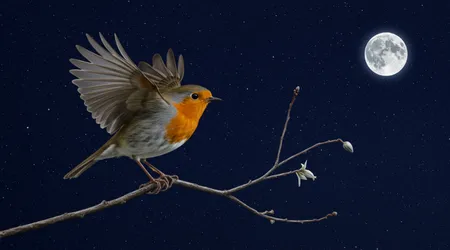Quantum Biology: How Birds May Use Quantum Mechanics to Navigate

Quantum biology unveils nature’s hidden secrets, merging physics with life’s mysteries. Birds, navigating thousands of miles with uncanny precision, may harness quantum mechanics for their journeys.
Anúncios
From European robins to Arctic terns, their ability to traverse continents, often alone, has puzzled scientists for decades. How do these creatures pinpoint their destinations without GPS or maps?
Recent research suggests that quantum biology offers answers, revealing a subatomic compass in their eyes.
This article dives into the fascinating intersection of quantum mechanics and avian navigation, exploring how birds might exploit quantum effects to chart their epic migrations.
We’ll unravel the science, highlight groundbreaking discoveries, and ponder what this means for future technology.
Anúncios
Migratory birds captivate us with their feats of endurance and accuracy. A single Arctic tern can travel 25,000 miles annually, returning to the same breeding grounds with astonishing fidelity.
Scientists long suspected environmental cues like the sun, stars, or Earth’s magnetic field guide them. But the magnetic field, weaker than a fridge magnet, poses a conundrum: how can it influence biological systems?
Enter quantum biology, a field blending quantum physics with life sciences, suggesting birds use quantum processes to “read” magnetic fields.
This revelation not only deepens our understanding of nature but also sparks questions about quantum applications in technology.
Why does this matter? Understanding quantum biology could revolutionize fields from navigation to medicine. If birds leverage quantum effects, could we mimic them for ultra-precise sensors?
This article will explore the mechanisms behind avian magnetoreception, the role of cryptochromes, and the broader implications for science.
With fresh insights from 2025 research, we’ll also address common questions about this emerging field, ensuring a clear, engaging journey through one of nature’s most extraordinary phenomena.
The Quantum Compass: How Birds Sense Earth’s Magnetic Field
Imagine a European robin, weighing mere ounces, flying solo across continents at night. Its ability to navigate relies on sensing Earth’s magnetic field.
This phenomenon, called magnetoreception, baffled researchers until quantum biology offered clues. In the 1970s, Klaus Schulten proposed that birds might use magnetically sensitive chemical reactions.
His radical idea suggested quantum mechanics underpins this ability, challenging traditional biology.
Schulten’s hypothesis centered on radical pairs molecules with unpaired electrons formed during chemical reactions. These electrons, governed by quantum rules, behave like tiny magnets.
Their “spin” states, influenced by Earth’s magnetic field, create a quantum superposition, a state where electrons exist in multiple configurations simultaneously.
This sensitivity allows birds to detect magnetic directions, acting as a biological compass. Recent studies, like those in 2021 by Hore and Xu, confirmed this in lab settings.
But how does this work in the wild? The robin’s retina, rich in cryptochrome proteins, likely hosts these reactions. When blue light hits cryptochromes, radical pairs form, their spins altered by magnetic fields.
This creates a chemical signal birds interpret as direction. Unlike human-made compasses, this quantum system operates at the atomic level, offering unparalleled precision.
Field studies on free-flying birds remain scarce, but lab experiments show magnetic fields disrupt orientation when cryptochromes are altered.
++ Slime Mold Intelligence: How a Brainless Organism Solves Mazes
This suggests a direct link between quantum processes and navigation. The challenge lies in mapping this mechanism in real-world migrations, where variables like weather complicate observations.
Could this quantum compass fail? Environmental changes, like geomagnetic storms, might disrupt these delicate signals.
Research from 2023 showed increased bird vagrancy during such events, hinting at quantum sensitivity to external noise. Understanding these limits could reveal how birds adapt to a changing planet.

Cryptochromes: The Molecular Key to Quantum Navigation
At the heart of this quantum mystery lies cryptochrome, a protein found in birds’ eyes. Cryptochrome-4 (Cry4), identified in migratory species like robins, is magnetically sensitive.
When blue light strikes Cry4, it triggers radical pair formation, a process rooted in quantum biology. This reaction, studied in 2021 by Xu and Hore, showed Cry4’s electron spins responding to weak magnetic fields.
Why Cry4? Unlike other cryptochromes, it binds strongly to flavin adenine dinucleotide (FAD), a molecule essential for radical pair formation.
Without FAD, no quantum compass exists. In lab tests, Cry4 from robins outperformed that of non-migratory chickens, suggesting evolutionary tuning for navigation. This specificity underscores nature’s precision.
Also read: The Forgotten Field of Psychobotany: Plants and Human Minds
But the story isn’t complete. Cryptochromes are also in plants and humans, regulating circadian rhythms. Could they have latent quantum roles in us?
The variation in Cry4’s gene sequence among migratory birds, noted by Liedvogel in 2025, suggests adaptive evolution, tailoring the protein for navigation.
The retina’s role adds complexity. Scientists hypothesize Cry4 aligns in specific orientations, creating a “magnetic map” in the bird’s visual field.
This map, processed in the brain’s Cluster N region, translates quantum signals into directional cues. Yet, how this signal travels remains unclear, a gap researchers aim to bridge.
Read more: The Unusual Behavior of Non-Newtonian Fluids
Future studies may target live retinas to visualize this process. If successful, they could confirm whether Cry4’s quantum effects produce a visible pattern, like a compass overlay in the bird’s vision.
Such discoveries could inspire quantum-based technologies, from navigation aids to medical sensors.
Implications for Science and Technology
What if we could harness quantum biology for human innovation? Birds’ quantum compasses offer a blueprint for ultra-sensitive magnetic sensors.
Current navigation systems, reliant on GPS, are vulnerable to interference. A bio-inspired quantum sensor could operate independently, revolutionizing aviation or space exploration.
In medicine, understanding cryptochromes could lead to breakthroughs in circadian rhythm disorders. If quantum effects influence biological clocks, new therapies might emerge.
A 2023 study on quantum biology’s role in photosynthesis suggests similar principles could optimize energy transfer in solar technology.
But challenges remain. Quantum systems are fragile, easily disrupted by noise. Birds somehow stabilize these effects in noisy environments, a feat engineers dream of replicating.
Collaborative efforts, like the 2025 Quantum Biology Gordon Research Conference, aim to decode these mechanisms.
Ethical questions arise too. Could manipulating quantum processes in organisms have unforeseen consequences?
As we mimic nature, we must tread carefully, balancing innovation with responsibility. Birds, after all, have perfected this over millennia.
The economic potential is vast. Quantum sensors could transform industries, from autonomous vehicles to environmental monitoring.
By studying birds, we might unlock compact, energy-efficient devices, reducing reliance on bulky electronics.
The Evolutionary Puzzle: Why Quantum Navigation?

How did birds evolve this quantum trick? Natural selection likely favored those detecting subtle magnetic cues. Over millions of years, cryptochromes refined this ability.
Liedvogel’s 2025 genomic study found Cry4 variations in migratory birds, suggesting evolutionary pressure for precision navigation.
Consider the Arctic tern, migrating from Arctic to Antarctic. Its journey demands pinpoint accuracy. A quantum compass, sensitive to minute magnetic changes, gives it an edge.
This adaptation likely emerged in species facing long, solitary migrations, unlike flock-dependent birds.
But not all birds use quantum navigation. Chickens, with weaker Cry4 responses, suggest it’s specific to migrators.
This divergence raises questions: do non-migratory birds retain latent quantum abilities? Comparative genomics could reveal when this trait evolved.
Environmental pressures, like shifting magnetic fields, may have driven this adaptation. Fossil records show ancient birds migrated, but we lack direct evidence of quantum mechanisms. Future paleontological finds could clarify this evolutionary timeline.
The interplay of quantum and classical biology fascinates. While quantum effects guide navigation, classical cues like stars complement them. This hybrid system showcases nature’s ingenuity, blending scales from subatomic to cosmic.
Table: Key Findings in Quantum Biology and Bird Navigation
| Year | Discovery | Source | Implication |
|---|---|---|---|
| 1978 | Radical pair hypothesis proposed | Schulten, Max Planck Institute | Quantum mechanics may underpin magnetoreception |
| 2000 | Cryptochrome as magnetoreceptor | Schulten | Identified protein for quantum navigation |
| 2012 | Cryptochrome-1 magnetic sensitivity | Hore, Oxford | Confirmed quantum effects in plants |
| 2021 | Cry4 magnetic sensitivity in robins | Xu & Hore, Nature | Strong evidence for avian quantum compass |
| 2025 | Cry4 genetic variation in migrators | Liedvogel, The Guardian | Evolutionary tuning for navigation |
Real-World Examples and Broader Impacts
Picture a lone robin crossing the Atlantic, guided by quantum signals in its eyes. This isn’t science fiction it’s happening now.
In 2023, researchers observed robins adjusting routes during geomagnetic storms, hinting at quantum sensitivity. Similarly, Arctic terns, tracked via satellite, consistently hit remote breeding sites, likely using this quantum compass.
Think of a smartphone with a quantum sensor inspired by birds. Unlike GPS, it could function underground or in space, transforming navigation. In medicine, quantum-inspired imaging could detect diseases earlier, leveraging cryptochrome-like sensitivity.
Statistically, migratory birds like robins navigate with 90% accuracy to breeding sites, per a 2021 study in Nature. This precision, driven by quantum biology, outstrips human technology. Could we achieve such efficiency?
An analogy: birds’ quantum compass is like a cosmic dance, where electrons twirl to Earth’s magnetic rhythm, guiding each step. This elegance inspires awe and innovation.
FAQs: Quantum Biology and Bird Navigation
How do birds use quantum mechanics to navigate?
Cryptochromes in their eyes form radical pairs, whose quantum spin states shift with Earth’s magnetic field, creating a directional signal.
Is quantum biology only relevant to birds?
No, it applies to photosynthesis, enzyme reactions, and potentially human circadian rhythms, with applications in medicine and technology.
Can humans develop quantum navigation systems?
Yes, bio-inspired quantum sensors could enhance navigation, though stabilizing quantum effects remains a challenge.
Why is quantum biology controversial?
Skeptics argue quantum effects are too fragile in biological systems, but evidence like Cry4’s sensitivity is changing minds.
This exploration of quantum biology reveals nature’s genius, blending the subatomic with the epic.
As we decode birds’ quantum compasses, we glimpse a future where quantum mechanics reshapes technology and medicine. What secrets will nature unveil next?
